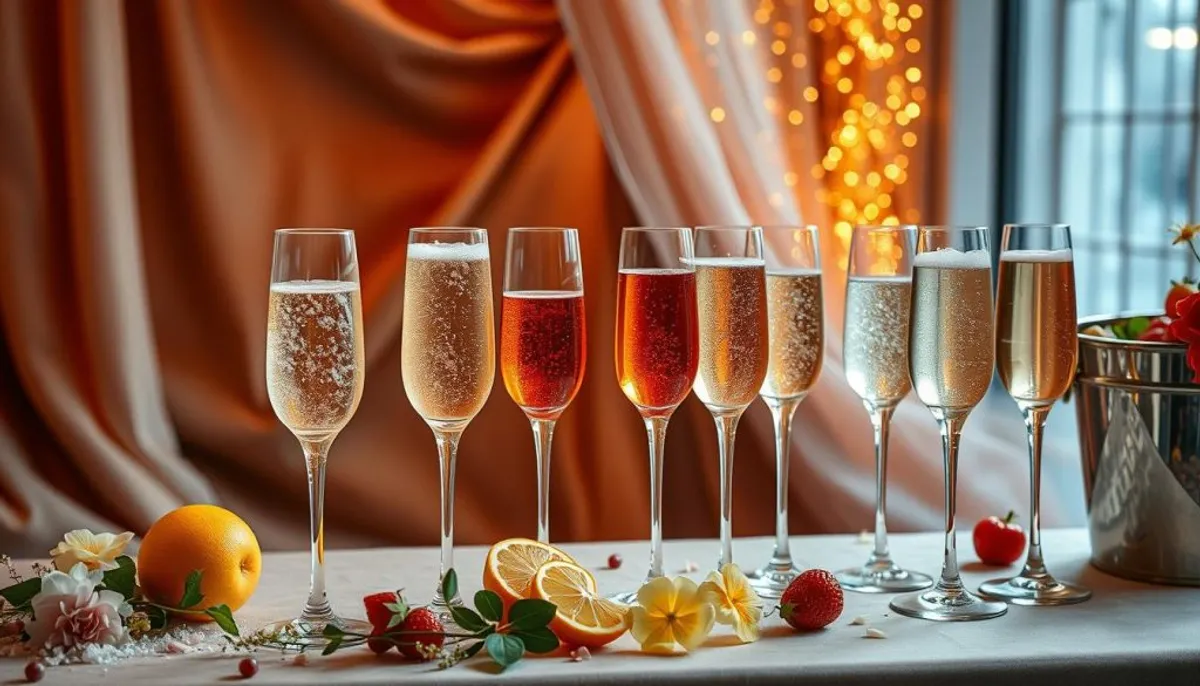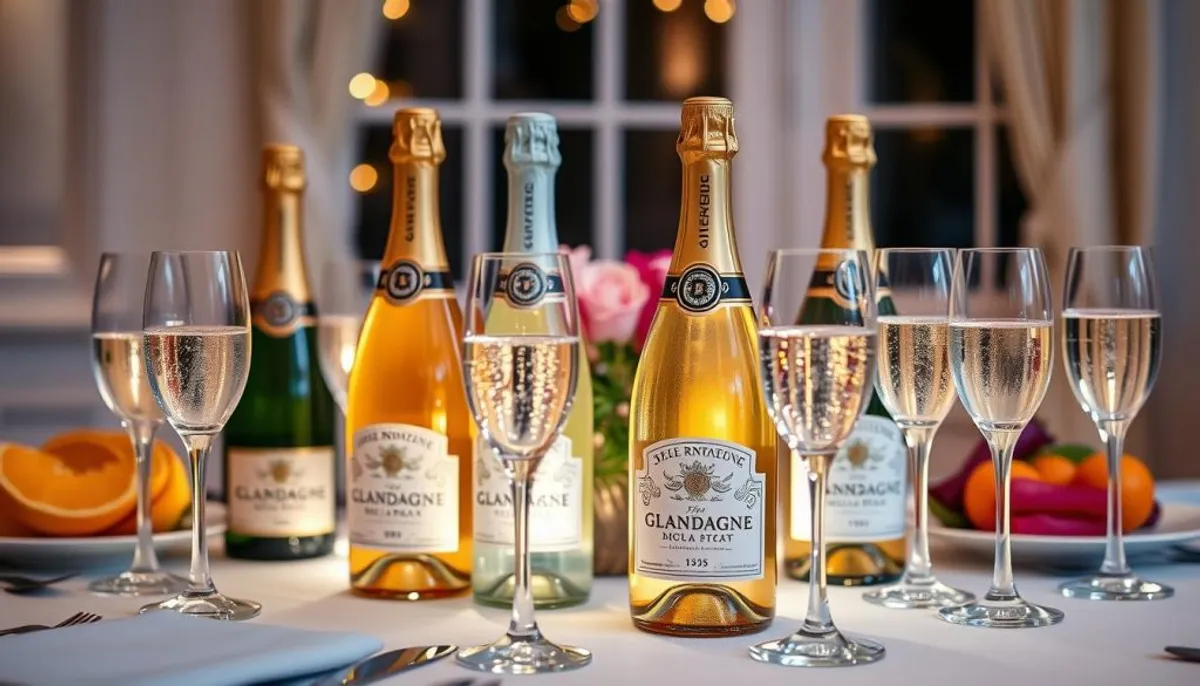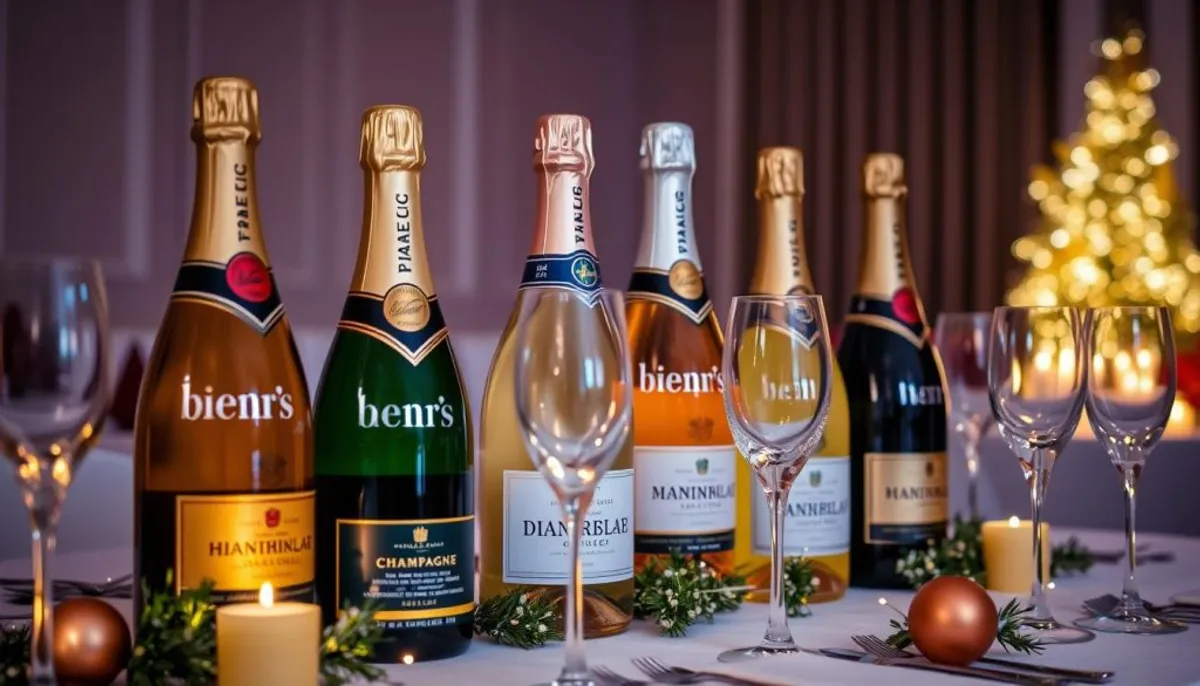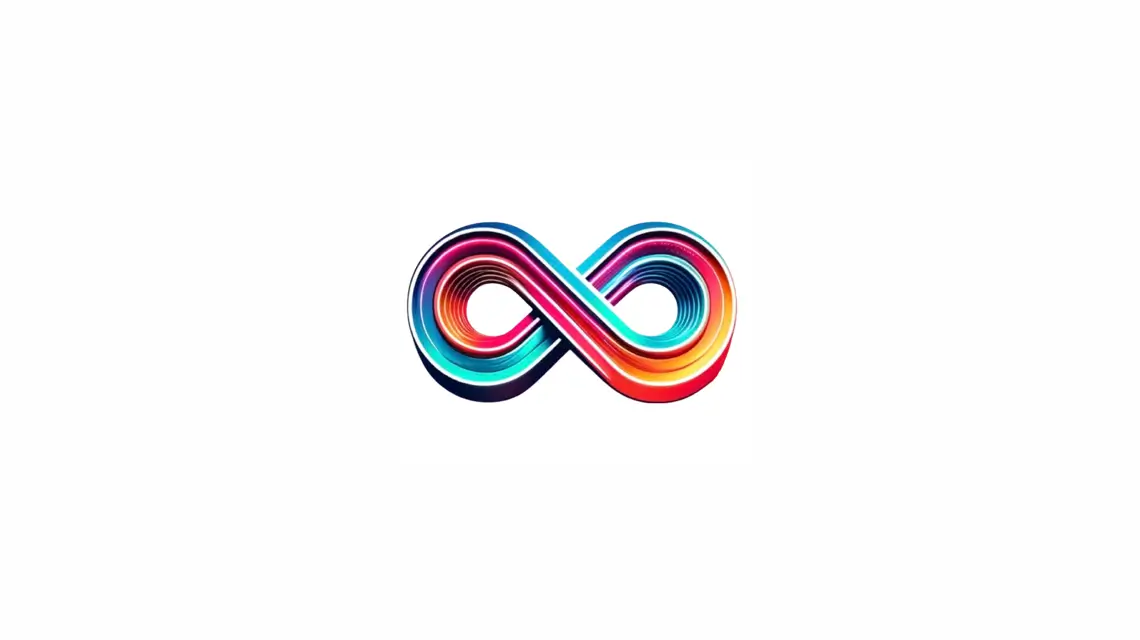Seeking the ideal alcohol-free champagne for your upcoming celebration? You’re in luck! The realm of non-alcoholic bubbly has expanded, offering a spectrum from affordable to premium selections. In 2025, zero-proof sparkling wines are poised to gain even more prominence.
Flavor profiles span from crisp and dry to super-fruity, catering to diverse tastes. Prices span a broad range, beginning at $3.50 for Nozeco and ascending to $55 for the luxurious Vinada Tinteling Tempranillo Rosé. Additionally, for those interested in local offerings, chandigarh champagne prices reflect a variety of options. With 48 distinct products available, finding the ideal choice is guaranteed.

Health-conscious individuals will find solace in the fact that most non-alcoholic champagnes have fewer calories and less sugar than their alcoholic counterparts. For instance, the Prosecco-like variety contains only 15 calories and 3g of sugar per 5-ounce glass.
Whether you’re organizing a wedding, a baby shower, or simply relishing the finer aspects of life sans alcohol, this guide will serve as your compass through the vibrant landscape of non-alcoholic champagne in 2025.
Key Takeaways
- Non-alcoholic champagne prices range from $3.50 to $55 per bottle
- 48 different zero-proof sparkling wine products are available
- Calorie content varies from 13 to 40 calories per 5-ounce glass
- All products contain less than 0.5% ABV, making them pregnancy-safe
- Flavors range from dry and crisp to sweet and fruity
- Many award-winning options are available in various price ranges
- Consult a healthcare professional if unsure about specific ingredients
Understanding Non-Alcoholic Champagne: What Makes It Special
Non-alcoholic champagne has emerged as a popular choice for those seeking a celebratory drink without the alcohol. This sparkling beverage captures the essence of champagne, minus the intoxicating effects. It’s crafted through a unique process that preserves its flavor and effervescence.
The Dealcoholization Process Explained
The production of dealcoholized wine, including non-alcoholic champagne, involves a specialized method to eliminate alcohol. Vacuum distillation is a prevalent technique employed. This method ensures the retention of the wine’s essence while significantly reducing alcohol levels to under 0.5% by volume.
Difference Between Regular and Non-Alcoholic Champagne
The primary distinction between regular and non-alcoholic champagne is their alcohol content. While traditional champagne boasts an alcohol percentage of around 12%, its non-alcoholic counterpart contains less than 0.5%. Despite the alcohol disparity, non-alcoholic versions strive to replicate the taste and fizz of their alcoholic counterparts.
Health Benefits and Considerations
Non-alcoholic champagne presents several health advantages. It is notably lower in calories, with some varieties containing only 40 calories per 8 oz serving. It is also a safer choice for pregnant women and individuals who abstain from alcohol for personal or health reasons. Certain brands incorporate adaptogens and nootropics, yet these may not be suitable for everyone.
| Aspect | Regular Champagne | Non-Alcoholic Champagne |
|---|---|---|
| Alcohol Content | ~12% | <0.5% |
| Calories (8 oz) | ~120 | ~40 |
| Safe for Pregnancy | No | Yes |
Top Premium Selections for Celebrations
The realm of luxury non-alcoholic champagne has evolved, presenting exquisite choices for those desiring a refined celebration sans alcohol. High-end alcohol-free sparkling wines now compete with their traditional counterparts in both taste and quality, including selections from independent wine merchants.
French Bloom Le Blanc emerges as a premium selection. This luxury non-alcoholic champagne, available at a 11% discount, is priced at $39. Its intricate flavors and delicate bubbles make it ideal for high-end gatherings.
Oddbird Blanc de Blancs is another exceptional choice. This high-end alcohol-free sparkling wine, available at an 81% discount, is priced at $25. It offers a crisp, refreshing taste that closely replicates traditional champagne.
- Thomson & Scott Noughty Alcohol-Free Sparkling Chardonnay
- Leitz Eins Zwei Zero Sparkling Riesling (15% off at $118)
- Freixenet Sparkling Non-Alcoholic Wine ($12 at Total Wine)
These premium selections boast complex flavor profiles and fine effervescence, rivaling traditional champagnes. They are ideal for toasts, celebrations, or simply savoring a luxurious fine dining experience alcohol-free experience.
| Brand | Price | Discount |
|---|---|---|
| French Bloom Le Blanc | $39 | 11% |
| Oddbird Blanc de Blancs | $25 | 81% |
| Leitz Eins Zwei Zero | $118 | 15% |
Budget-Friendly Options Under $15
Discovering affordable non-alcoholic champagne doesn’t require compromising on quality. The market is replete with cheap alcohol-free bubbly options that are budget-friendly. We will examine some cost-effective choices that add fizz to your celebrations without straining your wallet.
Best Value Brands
Several brands are notable for their quality and affordability. Freixenet’s brut cava alternative, priced at $9.99, captures the essence of traditional champagne with its crisp taste. For those desiring a French touch, a méthode champenoise bottle is available for just $11.95. Lila’s Italian sparkling, at $11.99, offers a refreshing choice for casual events.

Where to Find Deals
Major retailers such as Total Wine frequently carry a broad selection of affordable non-alcoholic champagne. Online marketplaces are also rich with deals. Be vigilant for seasonal promotions, which often see prices plummet, notably around holidays.
Bulk Purchase Savings
Acquiring in bulk can yield substantial savings. Retailers commonly offer discounts for bulk purchases. Consider dividing a case with friends to enjoy the savings without being tied to a single brand.
| Brand | Price | Style |
|---|---|---|
| Freixenet Brut Cava Alternative | $9.99 | Dry |
| French Méthode Champenoise | $11.95 | Traditional |
| Lila’s Italian Sparkling | $11.99 | Refreshing |
| Sparkling Riesling | $12.99 | Sweet |
| Lamberti House Pour | $12.99 | Light |
Non Alcoholic Champagne Price Comparison Guide
Non-alcoholic champagne prices span a broad range, catering to diverse budgets. This guide delves into the spectrum of alcohol-free sparkling wine costs, aiding in the selection of the ideal bottle for any celebration.
At the lower end, options like Fre Alcohol-Removed Sparkling Brut begin at $8. In contrast, premium choices such as Joyus Non-Alcoholic Sparkling White Wine can ascend to $30. The mid-range segment, featuring well-known brands like St. Regis and Lussory, generally falls between $12 and $20.
For those aiming for value, bulk purchases or multi-packs are worth considering. Gruvi, for instance, offers 4-packs of their Non-Alcoholic “Dry Secco” Prosecco and Bubbly Sparkling Rose for $15-$17. This approach provides an economical means to prepare for gatherings.
| Brand | Type | Price Range |
|---|---|---|
| Élivo Zero Zero Deluxe | Sparkling White | $20-$25 |
| Fre | Sparkling Brut | $8-$12 |
| Pierre Chavin Perle | Sparkling Rose | $20-$25 |
| Thomson & Scott Noughty | Sparkling Chardonnay | $11-$13 |
In evaluating non-alcoholic champagne prices, it’s crucial to consider production techniques, brand prestige, and flavor intricacy. These factors often underpin the higher costs of premium selections, promising a refined experience devoid of alcohol.
Award-Winning Non-Alcoholic Sparkling Wines
The realm of non-alcoholic champagne has witnessed a significant leap in quality and recognition. Today, many alcohol-free sparkling wines stand on par with their alcoholic counterparts in terms of taste and elegance, offering a fine dining experience that rivals traditional options. We will examine some exemplary choices that have garnered prestigious accolades and garnered widespread acclaim.
Gold Medal Winners
Several non-alcoholic sparkling wines have achieved gold medals at prestigious international competitions. French Bloom Le Blanc, boasting less than 0.5% ABV, emerged as the top winner at the 2022 World Sparkling Wine Awards. Its crisp acidity and fruity nuances captivated both judges and consumers.
Critics’ Choice Selections
Wine critics have warmly welcomed the non-alcoholic movement, commending several brands for their depth and genuine taste. Oddbird Blanc de Blancs is notable for its creamy bubbles and well-balanced flavor. This Swedish brand employs vacuum distillation to eliminate alcohol while retaining the wine’s subtle essence.
International Recognition
Non-alcoholic sparkling wines from around the globe have garnered international acclaim. Jøyus Non-Alcoholic Sparkling Rosé, an American creation, was awarded a gold medal at the San Francisco International Wine Competition. Its effervescent liveliness and subtle fruit flavors impressed the judges’ palates.
| Award | Wine | Country | Notable Features |
|---|---|---|---|
| World Sparkling Wine Awards Gold | French Bloom Le Blanc | France | Crisp acidity, fruity notes |
| Critics’ Choice | Oddbird Blanc de Blancs | Sweden | Creamy bubbles, complex flavor |
| San Francisco International Wine Competition Gold | Jøyus Sparkling Rosé | USA | Lively effervescence, delicate fruit |
These award-winning non-alcoholic sparkling wines exemplify the industry’s dedication to crafting superior alternatives for those in pursuit of the finest non-alcoholic champagne experience. With offerings from France, Sweden, and the USA, consumers can indulge in top-rated alcohol-free sparkling wines that cater to a wide range of tastes and occasions.
Best European Non-Alcoholic Alternatives
Europe is at the forefront of creating exceptional European alcohol-free champagne and sparkling beverages, including notable hungarian champagne brands. Wine aficionados can now indulge in the elegance of bubbly without the intoxicating effects. We will examine some exemplary choices that stand on par with their alcoholic counterparts.
In Spain, Freixenet, celebrated for its cava, presents a delightful non-alcoholic prosecco. This sparkling wine embodies the traditional cava’s crisp, fruity flavors. Another Spanish treasure is Elivo Zero, offering a wide array of premium alcohol-free drinks that appeal to both domestic and international consumers.
From France, Pierre Chavin Zero Rosé Non-Alcoholic Sparkling stands out. This rosé captures the essence of French winemaking, providing a sophisticated drinking experience. For a German perspective, Leitz Eins Zwei Zero Sparkling Riesling impresses with its tart green apple flavors.
In Italy, Princess Alternativa, originating from Verona, meets the increasing demand for lower-alcohol wines. Their ‘non-alcoholic alternative®’ series presents cava alternatives that maintain their flavor integrity. These European selections demonstrate that celebrating without alcohol can be equally satisfying, ideal for brunches, picnics, or any festive event.
| Brand | Country | Style |
|---|---|---|
| Freixenet | Spain | Non-alcoholic prosecco |
| Elivo Zero | Spain | Various styles |
| Pierre Chavin Zero Rosé | France | Sparkling Rosé |
| Leitz Eins Zwei Zero | Germany | Sparkling Riesling |
| Princess Alternativa | Italy | Cava alternatives |
Taste Profile Analysis
Non-alcoholic champagne flavors present a wide array of experiences for those with refined tastes. The spectrum ranges from sweet to dry, catering to diverse preferences. This exploration delves into the nuanced world of these celebratory drinks.
Sweet vs. Dry Options
The spectrum of non-alcoholic champagne flavors extends from sugary sweet to bone dry. Sweet varieties often feature fruit-forward notes, while dry ones offer a crisp, clean finish. Brands also offer balanced options, appealing to those who prefer a hint of sweetness without overwhelming the palate.
Bubble Intensity Ratings
Bubble intensity is crucial in the alcohol-free bubbly taste profiles. Some champagnes have fine, delicate bubbles that tickle the tongue. Others have lively effervescence, creating a more robust mouthfeel. The intensity of the bubbles can significantly enhance or complement the flavor experience.
Flavor Notes and Characteristics
Non-alcoholic champagnes showcase a broad range of taste notes. Common characteristics include crisp apple, ripe pear, zesty citrus, and floral honey. Brands also incorporate unique elements like vanilla or tropical fruits, creating distinctive polishing compounds and alcohol-free bubbly taste profiles.
| Flavor Profile | Sweetness Level | Bubble Intensity | Primary Notes |
|---|---|---|---|
| Classic Brut | Dry | Medium | Green apple, Citrus |
| Fruity Rosé | Semi-sweet | High | Strawberry, Peach |
| Elegant Blanc de Blancs | Extra dry | Fine | Pear, Almond |
| Dessert Doux | Sweet | Low | Honey, Apricot |
The market for non-alcoholic champagne is expanding rapidly. It is projected to grow from $2.66 billion in 2023 to $4.5 billion by 2032. This growth underscores the increasing demand for sophisticated, luxury jewelry sets and alcohol-free alternatives that offer complex flavors without sacrificing taste or experience.
Special Occasion Recommendations
Planning a celebration? Non-alcoholic champagne for events is the ideal choice for inclusive gatherings. Whether it’s an elegant dinner or an outdoor festivity, there’s a suitable alcohol-free drink for every occasion.
For sophisticated gatherings, Thomson & Scott Noughty Alcohol-Free Sparkling Chardonnay stands out. It’s the top choice among seven tested brands, closely mimicking real champagne. This makes it perfect for toasts and fine dining experiences.
Summer parties demand something refreshing. Jøyus Non-Alcoholic Sparkling Rosé is the answer, with its dry, crisp taste and hints of citrus and blackberries. It’s a favorite among rosé enthusiasts who desire a genuine taste without alcohol.
Outdoor events? Opt for Non-Alcoholic Wine in cans. Though some find it lacks a distinct wine taste, its dry and light flavor is ideal for picnics and beach outings.
For large gatherings, consider Freixenet or Rondel Zero Non-Alcoholic Cava. These affordable choices satisfy crowds with their balanced bubbles and crisp finish. Rondel Zero, in particular, offers a slightly sweet flavor, appealing to a broad range of tastes.
Remember, all these options have less than 0.5% ABV, ensuring they are safe for all guests, including expectant mothers. With 48 non-alcoholic champagne and sparkling wine products in our guide, you’ll find the perfect match for your next event.
Popular Brands and Their Price Points
Non-alcoholic champagne brands cater to various budgets, offering something for everyone. We’ll examine the most sought-after options across different price brackets. This will guide you in selecting the ideal alcohol-free sparkling wine for your next celebration.

Premium Range ($25+)
In the premium segment, luxury non-alcoholic champagnes promise unparalleled taste. French Bloom Le Blanc, priced at $39, is renowned for its refined flavor. For those seeking an exquisite touch, luxury event decor chicago can elevate any gathering. Oddbird Blanc de Blancs, available at $25, is celebrated for its crisp, refined notes.
Mid-Range ($15-$25)
The mid-range segment provides excellent value. Thomson & Scott Noughty, at $22, is a favorite for its organic and vegan-friendly attributes. Jøyus Non-Alcoholic Sparkling Rosé, priced at $25, offers a delightful pink alternative with fruity undertones.
Economy Range (Under $15)
For those on a budget, quality alcohol-free sparkling wines are accessible. Sutter Home Fre Brut, priced at $10, presents a crisp, dry option. St Regis Nosecco, at $9, offers a sweet, bubbly experience. Rondel Zero, costing $11, completes the economy range with its balanced flavor.
| Price Range | Brand | Price |
|---|---|---|
| Premium | French Bloom Le Blanc | $39 |
| Premium | Oddbird Blanc de Blancs | $25 |
| Mid-Range | Thomson & Scott Noughty | $22 |
| Mid-Range | Jøyus Non-Alcoholic Sparkling Rosé | $25 |
| Economy | Sutter Home Fre Brut | $10 |
| Economy | St Regis Nosecco | $9 |
| Economy | Rondel Zero | $11 |
With these varied alcohol-free sparkling wine prices, finding the perfect bottle for any occasion is effortless. Whether it’s for a grand celebration or a casual get-together with friends, there’s a suitable choice for everyone.
Storage and Serving Tips
Ensuring the quality and flavor of non-alcoholic champagne hinges on proper storage. Store bottles in a cool, dark environment with temperatures ranging from 10 to 15ºC. For extended storage, position the bottles on their side to preserve the cork’s moisture.
Chill alcohol-free bubbly to 8-10ºC for the best taste. Surprisingly, a tulip-shaped glass is superior to a flute for bubble preservation and aroma enhancement. Pouring gently is essential to maintain carbonation.
After opening, consume within 2-3 days for peak flavor. Brands like Surely offer canned options, simplifying storage and portability. It’s important to note that non-alcoholic champagne generally contains 0.5% alcohol by volume or less.
For a distinctive experience, try TÖST Non-Alcoholic Sparkling Beverage, which combines white tea, cranberry, and ginger. Or explore Lyre’s Classico, featuring apple, peach, and lime notes. These alternatives offer exciting flavors while following proper storage guidelines.
| Brand | Key Features | Storage Tip |
|---|---|---|
| Surely | 40 calories per 8 oz glass | Store cans in refrigerator |
| Noughty | Lower sugar content | Keep bottles upright in cool area |
| Freixenet | Operating since 1861 | Store horizontally in wine rack |
Conclusion
The best non-alcoholic champagne guide uncovers a rapidly expanding market, with premium-plus products leading the charge, accounting for 87% of growth in 2022-2023. This summary of alcohol-free sparkling wine showcases the industry’s vibrant evolution, meeting a wide range of preferences and financial capacities.
Luxury brands, such as Society De La Rassi and leonardo dicaprio, are redefining the landscape with their offerings. They present a $70 Chardonnay-based sparkling wine, boasting a mere 0.5% ABV and only 15 calories per serving. The non-alcoholic champagne market, estimated at $12.12 billion in 2023, is forecasted to soar to $28.4 billion by 2032, experiencing a 9.92% CAGR.
Currently, non-alcoholic wine consumption hovers below 1.5% of the total wine market. Yet, the allure of younger demographics hints at a brightening future. Advancements in technology are continually enhancing production techniques, thus broadening the spectrum of top-tier non-alcoholic champagnes. These developments ensure that alcohol-free celebrations can now be as elegant and refined as their alcoholic counterparts.
RelatedRelated articles



